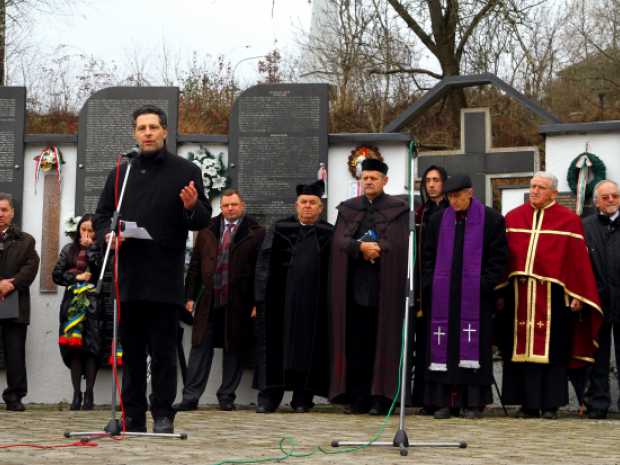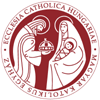At the end of 1944, by defiling the front line and calming down weapons brought the Transcarpathian Hungarians and Germans not the era of peace and calmness but a period when they had to face up further hardships. According to the created Doctrine of Collective Guilt – which declared the collective guilt of Germans and Hungarians – and the consequences of the lost World War for ten thousands of people belonging to these ethnics the were deportations, forced labour and malenykij robot.
Intentions of Stalin and the Soviet leadership concerning the punishment of Hungarian nation were already obvious in 1943, when Molotov, the Soviet Peoples Comissar for Foreign Affairs wrote the following lines to A. C. Kerr, British Ambassador to Moscow: “The Soviet government thinks that for the armed help which Hungary rendered to Germany … not only the Hungarian government has to take responsibility but more or less Hungarian population too.”
The Soviet will to punish the Hungarian nation was obvious in the case of Transcarpathian Hungarians too, as Stalin decided to attach this territory to the Soviet Union. Systematic, ruthless imposing of the Soviet regime began in Transcarpathia in October 1944, when the soldiers of the Soviet Army, exactly the 4th Ukrainian Front appeared in the region. Among the numerous features of the sovietization of Transcarphatia – establishing the soviet(council) system, organizing collective farms, violent gathering of crops, forcible nationalization, and struggle against the historical Churches – the most tragic measure of the Soviet power in Hun¬gary and also in Transcarpathia was the malenykij robot.
On the 12th of November 1944 the Military Council of the 4th Ukrainian Front gave the notorious top secret command No.0036:
(Top secret) Command No. 0036 of the Military Council of the 4th Ukrainian Front, which occupied Transcarpathia
“1. The military governments of cities, towns and bigger rural settlements are obliged to register the soldiers and officers who were in service in the German and Hungarian armed forces irrespective of their nationality, from November 14 up to November 16.
2. We have to compile a list of all German and Hungarian men between the ages of 18 and 50 liable to military service who currently live on the territory of the liberated Transcarpathian Ukraine, as well as the officials and clerks of the Hungarian police and gendarmerie who reside on the territory of the liberated Transcarpathian Ukraine. … The military commanders have to inform the persons in question about their obligation to appear again on November 18…. The persons in question who live on the territory of the liberated Transcarpathian Ukraine have to be guided into POW transit places in separate groups according to the prepared lists under convoy.
Major general Fadeyev, commander of the NKVD-quads, responsible for the control of the hinterland, has to direct his corps to intensify efforts in order to find and arrest the listed persons.”
Next day appeared the Command No. 2 of the Town government was declared and called upon the male population aged 18-50 years of Hungarian and German nationality to register themselves. The warning pointed out the 16th of November as the last day of registration. It also informed the population that all those who did not register would be arrested and courtmartialled. Besides the placards announcing the command, in the settlements they also proclaimed the registering obligation. It was announced several times every day and in some places it was also emphasized that if the obliged person did not report, all of his family would be put to the sword. Different pretexts were issued by the representatives of the new regime: in some settlements people were gathered for the reason of taking over such a certificate which authorized them to move freely in the area “liberated” by the Red Army; in other settlements – and in the most villages – the explanation was the only 3 day long reparation and re¬storing work, the “little work” or the “malenykij robot” whose concept has become a terminology and it has come into general use also in Hungarian language thus hallmarking the Soviet measures concerning the deportation of Hungarian and German civilians. Sorting people out according to their nationalities in different gathering places may be concluded that the main reason of deportation was the ethnic cleansing, to which the doctrine of collective guilt gave suitable ideological principle for the Stalin regime. Those who declared themselves Rusyns, Ukrainians or Slovaks – since nationality was determined by themselves – or could say at least the Lord s Prayer in Rusyn or Slovakian language they were given a certificate and were allowed to go home. The first marching columns of gathered Transcarpathian male popu¬lation were sent off on 18th November 1944 towards the relocation center and transit camp in Szolyva. For the prisoners who were driven by strict armed escort it was forbidden to step out the line or to leave their place. As they spent nights in different unheated buildings or in hepenair on their way to the camp in cold November, most of them had got cold by the time they arrived in Szolyva. The situation became more seri¬ous when the Soviet soldiers took their shoes and coats away. In Szolyva a large number of deportees died because of the inhuman conditions, starvation, epidemic and cold. Here the internees already were forced to do different jobs: building bridges, carrying woods which were typical during all the time of the deportation. The deportees were intended to be used as free labour force in order to rebuilt the Soviet Empire being in ruins after war. Those starved, frozen to the bone and humiliated in their human dignity prisoners who survived the initial trials/tribulations in Szolyva were made to march through the Uzhok pass to Sztarij or Novij Szambor. Here they were put on trains leaving for different camps in the Soviet Union from where most of them never came back.
But this was not the only wave of deportations from Transcarpathia. In December 2014, Command No. 0060 was issued which concerned all German men between the ages of 17 and 45 and women between the ages of 18 and 30 able to work. Only those few women who have a child under the age of 1 year could escape.
Persons deported with reference to malenykij robot were taken in so- called GUPVI (Glavnoje Upravlenyije Vojennoplennih i Internyi-rovan- nih) camps which were under the control and supervision of the NKVD as well as the GULAG camps. But there were significant differences between the two camp systems. The GUPVI camps were set up for POWs and internees who were dragged away in large numbers ignoring their personal identification. The Soviet authorities focused merely on meeting the plan figures as well as on the isolation of a given nationality just like in the case of the Transcarpathian Hungarians. On the other hand, in the case of people who were taken off to GULAG camps the prisoners per¬sonal identity was very important. The representatives of the occupying Soviet authority presumed that they could hinder the process of establish¬ing the regime. Therefore they became inmates by show trials organized against them and directed to GULAG forced labour camps.
The news about inhuman circumstances in the camps was coming to Hungary even at the end of 1944. On December 26, 1944, right after the Provsional National Government was formed, it made a complaint against the deportations of the civilian population to the Soviet government. On January 7, 1945 Hungarian Prime Minister Bela Miklos Dalnoki wrote a letter to the Soviet government aiming at releasing the deported civilians in which he referred respectively to the people carried forcibly away from Transcarpathia: “From Bereg county Hungarian men were taken off to labour service nearly two months ago. From town Beregszasz and the neighbouring villages, which belong to Czechoslovakia in accordance with the Trianon contract, the Hungarian population between 18-50 years was taken off on the 19th of November. On the 21st of November, men between 18-50 years were also taken off from the Trianon area of Bereg County, from the villages east of the highway of Beregszasz-Vasarosnameny. Out of these people priests, Rusyns, Gipsies, Jewish or Greek Catholic religious people were sent back to their families from Beregszasz. […] According to the com¬plaints received, the accommodation and nutrition of the Hungarians being at forced labour is very poor. A lot of them became ill as they are without any warm clothes. […] The release of the Hungarian men who have been at forced labour for a long time became necessary and that is why 1 ask you to order the release of these people.”
Men of military age deported in the course of malenykij robot, in some documents are listed as prisoners of war (POWs), while in other cases they are marked as internees. Mentioning together civilians in¬terned from Transcarpathia and prisoners of war in different documents and being treated in the same way it may be concluded that Soviet leader¬ship considered deported civilians – even who had never held weapons in their hands – as potential prisoners of war. About those who were considered to be prisoners of war by the Soviet leadership we can get informa¬tion from the decision approved in 1941 by the Council of Peoples Com¬missars of USSR: “All those qualify prisoners of war who belong to armed forces of states being at war with the Soviet Union, who fell into captivity during military operations as, as well as the civilian people of these countries who were internee to the territory of the Soviet Union”.
People’s Council of Transcarpathian Ukraine in summer of 1945 issued a circular letter in each settlement about making a list of prisoners of war and civilians being in different camps in the USSR. Since the register applied to all the men, who at that time were in any camp of the Soviet lager system, civilians who were deported in course of malenykij robot as well got to the list as prisoners of war who got in captivity as the con¬sequence of moving the front line. According to this list, in summer of 1945 more than 27 thousand inhabitants of Transcarpathia were kept in prison in POWs camps and labour camps, and a great part of them never returned to their homeland. Many of those who could return died within a short time of different illnesses caught in the camp, but malenykij robot also left a permanent trauma in survivals’ souls who were tortured physi¬cally, humiliated and forced to lose their human dignity.
This high rate of deportations besides the personal tragedies has meant a communal trauma and tragedy for the Transcarpathian Hungarians since the consequences of the largest deportation has influenced the number of community in a negative way. The deportees’ rehabilitation – who received even greater punishment because of their origin than com¬mon criminals – has not been done till nowadays.
In the decades of existence the Soviet Union it was forbidden to re¬member, or even to talk publicly about what happened in 1944 and the history of deportations was on the first places on the list of taboo top¬ics. Appearance of the first writings and the first public commemoration which meant the breakthrough of the wall of silence might happen only at the end of 1980s or at the beginning of 1990s. Thanks to memoirs and narration of survivors, through memorials, publications and conferences analyzing the events, malenykij robot became the defining element of the collective memory of Transcarpathian Hungarians.
It is important to treat these events in public thinking in compliance with its significance and it is also important to remember this sad period of our national history. It is proved fact that if memory does not get a form, after a certain time it will be forgotten and only those events remain in the common memory, remembrance of which is traditionally cultivated.
Original text: Emlékkönyv a „málenykij robot” kárpátaljai áldozatairól – 1944-2014
(Memorial book Transcarpatia victims of „málenykij robot”)















